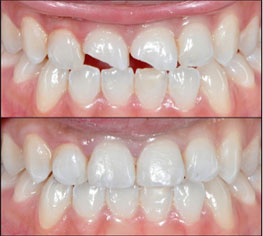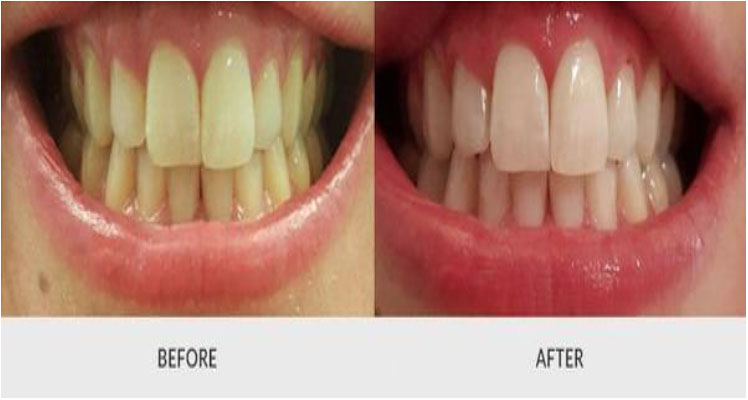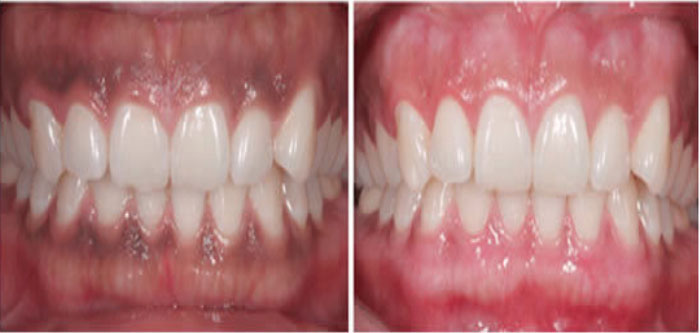Dental Filling or Bonding

If you have chipped off just a small piece of tooth enamel, your dentist may repair the damage with a filling. If the repair is to a front tooth or can be seen when you smile, your dentist will likely use a procedure called bonding, which uses a tooth-colored composite resin.
Bonding is a simple procedure that typically does not require numbing the tooth. To bond a tooth, the dentist first etches its surface with a liquid to roughen it and make the bonding material adhere to it. Next, the dentist applies an adhesive material to the tooth, followed by the bonding material. After shaping the bonding material to look like a natural tooth, the dentist uses an ultraviolet light to harden the material.
Dental Cap or Crown

If a large piece of tooth breaks off or the tooth has a lot of decay, the dentist may grind or file away part of the remaining tooth and cover it with a crown, or tooth-shaped cap, made to protect the tooth and improve its appearance. Permanent crowns can be made from metal, porcelain fused to metal, all resin, or all ceramic. Different types have different benefits. All-metal crowns are the strongest. Porcelain and resin crowns can be made to look nearly identical to the original tooth. If the entire top of the tooth is broken off but the root is still intact, the dentist can often place a pin or a post in the root and build up enough of a structure onto which a crown can be made. Later, the dentist can cement the crown over the pin or post-retained restoration.
A diastema is an area of extra space between two or more teeth. The two front teeth of the upper jaw area is where diastema is most frequently seen. Many children experience diastema as primary teeth fall out, though in most cases these spaces close when the permanent teeth erupt. Diastemas may also be caused by a tooth size discrepancy, missing teeth or an oversized labial frenum, the tissue that extends from the inside of the lip to the gum tissue where the upper two front teeth are located. Secondary reasons involve oral alignment issues such as an overjet or protrusion of the teeth
VENEERS

A veneer is a thin layer of restorative material placed over a tooth surface, either to improve the aesthetics of a tooth, or to protect a damaged tooth surface. There are two main types of material used to fabricate a veneer, composite and dental porcelain.Veneers are an important tool for the cosmetic dentist. A dentist may use one veneer to restore a single tooth that may have been fractured or discolored, or multiple teeth to create a“Hollywood” type of makeover. Many people have small teeth resulting in spaces that may not be easily closed by orthodontics. Some people have worn away the edges of their teeth resulting in a prematurely aged appearance, while others may have malpositioned teeth that appear crooked. Multiple veneers can close these spaces, lengthen teeth that have been shortened by wear, fill the black triangles between teeth caused by gum recession, provide a uniform color, shape, and symmetry, and make the teeth appear straight.Dentists also recommend using thin porcelain veneers to strengthen worn teeth. Thin veneers is an effective option for aging patients with worn dentition. In many cases, minimal to none tooth preparation is needed when using porcelain veneers.
Overview of Teeth Whitening
Teeth whitening is used to correct discoloration of the teeth by removing the brown and yellow staining. The term “teeth whitening” can refer to a number of techniques to improve the brightness of the patient’s teeth. Among them are chemical whitening, mild acid whitening, abrasive teeth brightening and the newest technique, laser teeth whitening.

Teeth Bleaching Are chemical process used to lighten the color of the patient’s teeth. The procedure can be performed entirely in the cosmetic dentist’s office or it can be performed by the patient in their home, using a materials provided by the dentist. The home method is often used because it saves the patient from having to make an office visit for each treatment.
Before the patient embarks on the home teeth whitening regimen, the cosmetic dentist creates a custom mouth tray for the patient. The custom tray is a critical component of the treatment. It ensures that the correct amount of whitening solution is used and that the patient’s teeth are properly exposed to the whitening solution. The custom made mouth tray provides for a better fit than a one-size-fits-all mouth tray to help increase the margin of patient safety.
The steps in the home teeth whitening regimen are fairly straightforward. The cosmetic dentist’s office provides the patient with the materials and instructions and also answers questions the patient may have about the routine. Your dentist’s office can also provide you with off-site supervision should you have any questions once you’ve begun. A home whitening session can last for two to three hours, during which time you will have the tray and solution in your mouth. Depending upon your needs and desired results, your dentist may instruct you to keep the tray in your mouth overnight. Typically, you will follow your home teeth whitening regimen for two to three weeks, after which time you will return to your cosmetic dentist for a follow up visit.
How long does teeth whitening last?
Teeth whitening are not a permanent procedure. Results can last for one to or more years, depending upon your personal habits. In most cases, the whitening procedure is very effective and the patient is pleased with the results.

Need More Info about Cosmetic Dentistry
CALL US FOR A QUICK APPOINTMENT
+91-9963100600, +91-9640100600
Kondapur Branch
-
Mon-Sat
09:00 AM - 09:00 PM
Sunday
10:00 AM - 02:00 PM
Contact Info
-
+91 9963100600
- dentalkims@gmail.com
Secunderabad Branch
-
Mon-Sat
09:00 AM - 07:00 PM
Sunday
Only on Call
Contact Info
-
+91 9640100600
- dentalkims@gmail.com

